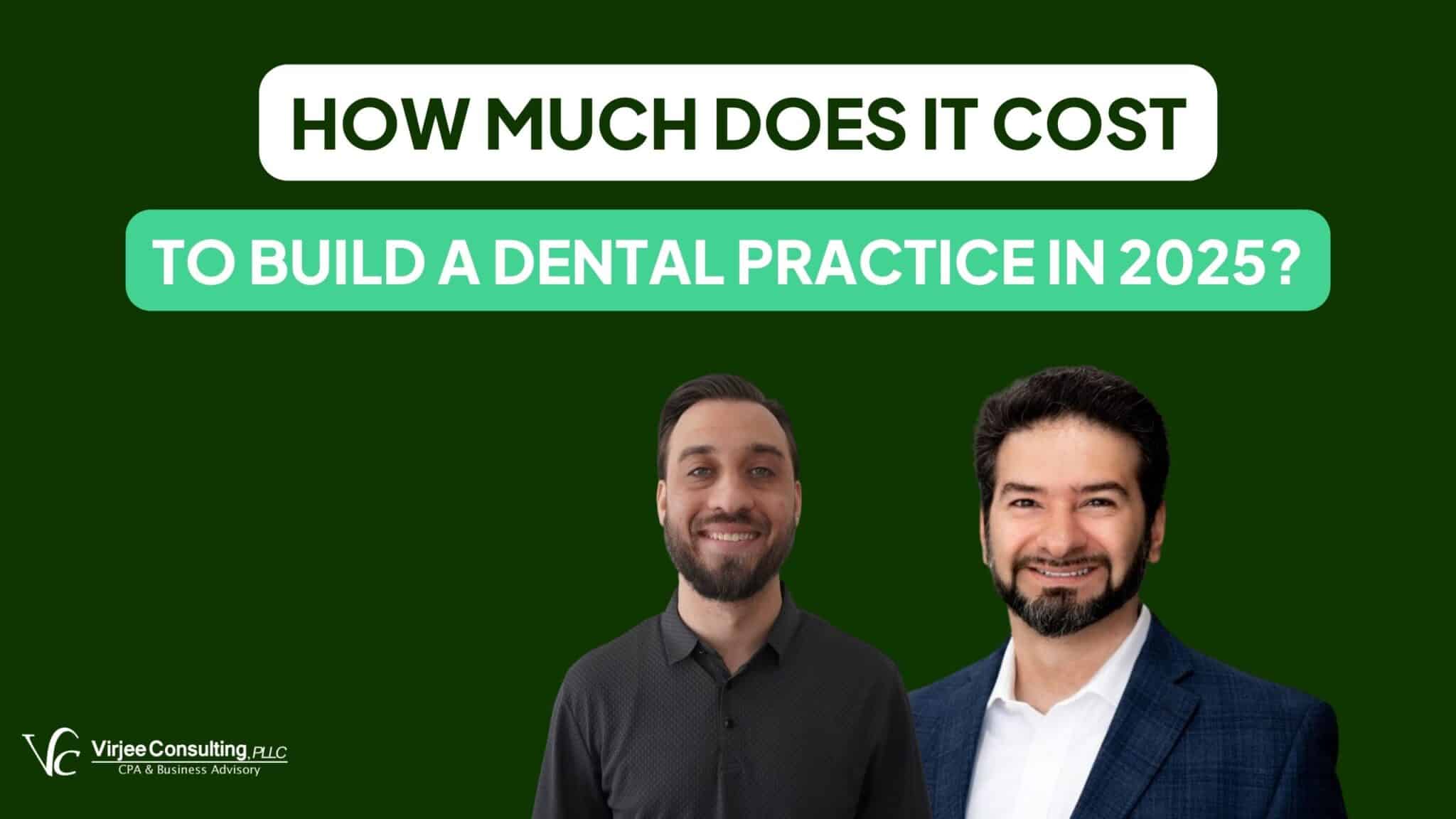So, you’re finally ready to build your own dental practice? That’s exciting—and probably a little terrifying, too.
You’ve spent years working as an associate, helping grow someone else’s business, and now it’s time to create something of your own. But before you start envisioning your name on the front door and a fully booked schedule, there’s one big question we need to tackle: How much does it actually cost to build a dental practice in 2025?
You’ve probably heard numbers thrown around—maybe a colleague told you they did it for $500,000, or you read somewhere that it can run over a million. The truth is, there’s no one-size-fits-all answer. The cost depends on where you’re opening, how big your space is, how much technology you want, and how lean or luxurious you’re going from the start. But if you’re planning to build a modern, fully equipped, and competitive practice in 2025, expect to spend somewhere between $750,000 to $1.2 million to do it right.
Let’s break down exactly where that money goes so you know what to expect and where you might be able to save.
Securing Your Location: Leasing vs. Buying
The first big decision you’ll make is where to set up shop—and whether to lease a space or buy your own building. Leasing is the more common choice for new dentists because it requires a lower upfront investment. You’ll still need to budget for tenant improvements (because most office spaces aren’t already set up for dental work), but you avoid the hefty down payment and mortgage that come with purchasing real estate.
For a prime location, expect to pay anywhere from $5,000 to $15,000 per month in rent, depending on the city.
But the real kicker is the cost of turning that blank space into a functional dental office. Plumbing for chairs, electrical for all your equipment, cabinetry, flooring, reception—these renovations alone can run between $150,000 to $400,000, even in a leased space.
If you decide to buy a building, your upfront costs jump significantly. A small commercial space in a desirable area can easily cost $750,000 to $2 million, and that’s before renovations. The advantage is long-term equity, but the tradeoff is a massive initial cash investment.
No matter which route you take, real estate and buildout costs will likely be one of your biggest expenses, so it’s worth getting multiple quotes before committing.
The Equipment Price Tag: What You Actually Need to Buy
If you’ve ever browsed a dental supply catalog, you know this part isn’t cheap. Outfitting your practice with the right equipment can cost anywhere from $250,000 to $500,000, depending on how advanced you want to go.
At a minimum, you’ll need:
- Dental chairs: A high-quality chair costs around $10,000 to $15,000 each, and you’ll likely want at least three to start.
- X-ray and imaging equipment: A CBCT scanner alone can run $100,000 or more. Even a basic digital X-ray setup is at least $25,000 to $50,000.
- Sterilization center and lab equipment: Expect to spend $40,000 to $75,000 on sterilization units, compressors, and lab tools.
- Handpieces, instruments, and supplies: The little stuff adds up fast—budget at least $50,000 for these.
Then there’s technology. A dental practice in 2025 has to be digital, which means investing in practice management software, intraoral scanners, digital charting, and maybe even 3D printing. Software licensing and hardware upgrades can cost $20,000 to $50,000, depending on the platform you choose.
Payroll: Your Biggest Ongoing Cost
A dental practice is nothing without a strong team, but staffing is also one of the largest ongoing expenses.
Even if you start small, you’ll need at least:
- A front desk coordinator to handle scheduling and insurance billing, which typically costs $40,000 to $60,000 per year.
- A dental assistant, who earns about $45,000 to $65,000 annually, depending on experience.
- A hygienist, who commands a salary of $75,000 to $120,000 per year.
Some dentists try to go ultra-lean at first, but cutting corners on staff usually backfires. If patients are waiting too long because you’re short-handed, they’ll go elsewhere. Plus, without a solid front desk person, your collections and scheduling can become a nightmare.
All in, payroll will probably account for 25–30% of your revenue, so be sure to factor it into your financial plan.
Marketing: Because Patients Won’t Just Show Up
A brand-new dental practice doesn’t come with patients—you have to attract them. That means marketing is a must, and it’s one of the biggest mistakes new practice owners underestimate.
To build a steady flow of new patients, expect to invest in:
- A professionally designed website with SEO ($5,000–$10,000 upfront)
- Google Ads and social media advertising ($2,000–$5,000 per month)
- Local marketing efforts like mailers, promotions, and sponsorships ($5,000–$15,000)
Your marketing budget should be at least $50,000 in your first year—more if you’re in a highly competitive area.
Other Costs That Sneak Up on You
Beyond the obvious expenses, there are a ton of smaller costs that add up fast. Insurance—malpractice, liability, disability, and business coverage—can easily cost $10,000 to $20,000 per year. Legal fees and accounting services to set up your business properly will run at least $5,000 to $15,000. Then there are supplies, lab fees, software subscriptions, and the ever-annoying bank fees and credit card processing charges.
A big one that many new owners forget? Working capital. Even if you open with a packed schedule, insurance reimbursements take time to roll in. It’s smart to have $50,000 to $100,000 in cash reserves to cover payroll and expenses for the first few months.
The Final Tally: What You Need to Open Your Doors
So, when you add it all up, how much does it really cost to build a dental practice in 2025?
- Office space and buildout: $250,000–$500,000+
- Equipment and technology: $250,000–$500,000
- Staffing: $150,000–$300,000 per year
- Marketing and branding: $50,000+ in the first year
- Insurance, legal, and miscellaneous: $50,000+
Total estimated startup cost? $750,000 to $1.2 million.
That’s a huge investment, but done right, it’s one that will pay off. If you structure your loans and expenses properly, you’ll be profitable within 12 to 24 months. Just remember: plan ahead, don’t overspend on things you don’t need, and make sure you have enough cash to cover the first six months of operations.
How Do You Afford a $1 Million Startup Cost?
Alright, so now that we’ve gone over the numbers, you’re probably thinking, How the hell do I come up with a million dollars?
The good news is, you don’t need that cash sitting in your bank account. Most dentists finance their startup costs through a combination of loans, cash savings, and sometimes outside investments.
Let’s go through your options.
1. Taking Out a Practice Loan (Your Main Source of Funding)
For most dentists, the majority of the startup cost comes from a practice loan. Banks and lenders understand that dentists are a good bet—dental practices have high-profit margins, and default rates on dental loans are really low. That’s why banks are often willing to lend you up to $750,000 to $1.2 million to start your practice, assuming your credit is solid and you have a good business plan.
There are two main types of loans dentists use:
- SBA Loans – The Small Business Administration (SBA) loan is a popular option for startups. You’ll typically need to put 10% down, so if you’re borrowing $1,000,000, that means you need $100,000 in cash upfront. Interest rates are usually 7–10%, and repayment terms can go up to 10–25 years.
- Traditional Bank Loans – If you have strong credit, you might qualify for a dental-specific practice loan from a big lender like Bank of America, Wells Fargo, or a specialized healthcare lender. These often have lower down payments and better terms than SBA loans, but you’ll still need to show you have enough savings and a solid plan.
With either loan type, your monthly payment will depend on your total loan amount, interest rate, and repayment term. If you borrow $1 million at 8% interest over 10 years, your monthly loan payment would be about $12,000. That might sound like a lot, but keep in mind that a successful dental practice can generate $1 million+ in annual revenue once fully operational.
Want to know exactly how banks decide whether to approve you for a loan?
We’ve got a great video on YouTube that breaks it all down. In this episode, we sit down with Lauren Camacho, VP of Sales at Bank of America Practice Solutions, who has helped over 1,000 dental offices secure financing. She covers how to make yourself bankable, the best loan options for dental startups, and the biggest financing mistakes to avoid. If you’re serious about getting funding, you need to check this out:
2. Cash Savings: How Much Do You Need?
Even if you’re financing most of your startup costs with a loan, you still need cash reserves. Banks don’t like lending money to someone with an empty bank account—they want to see that you can cover the first few months of expenses while your practice gets off the ground.
A good rule of thumb is to have at least $75,000 to $150,000 in cash reserves. This money covers:
- Lease and security deposit
- Staff payroll (before insurance reimbursements start coming in)
- Marketing and patient acquisition costs
- Unexpected expenses (because there will always be unexpected expenses)
If you don’t have this saved up, you may need to delay opening or find another way to raise capital.
3. Outside Investors or Partners (If You Don’t Want to Do It Alone)
If the idea of taking on a million-dollar loan alone makes you sweat, you could consider bringing in a partner or investor. This could be another dentist looking to co-own the practice, or it could be a silent investor who funds part of the startup costs in exchange for a percentage of future profits.
Just be careful—partnerships can get messy if you don’t clearly define roles, responsibilities, and profit-sharing upfront. If you go this route, make sure to work with an attorney to set up a fair partnership agreement.
4. Alternative Financing Options (For Smaller Needs)
Let’s say you qualify for a loan, but you still need a little extra cash for things like working capital or initial marketing expenses.
Here are a few options:
- Business Credit Cards – A high-limit business credit card can help cover small expenses, but avoid carrying a balance long-term since interest rates are high.
- Equipment Financing – Instead of paying $200,000 upfront for dental chairs and X-ray machines, some companies offer 0% financing on equipment, letting you spread the cost over a few years.
- Lines of Credit – A business line of credit gives you access to cash when needed, and you only pay interest on what you borrow.
The Bottom Line: Can You Actually Afford It?
Yes—if you plan smartly and don’t overextend yourself. Banks are willing to lend to dentists because they know that, when done right, a dental practice is a very profitable business. But the key to affording it isn’t just getting a loan—it’s making sure your revenue is enough to cover all your expenses while still paying yourself a decent salary.
That’s why you need a solid business plan before you start. Make sure you’re picking a location with enough demand, investing just enough in equipment to get started (without overspending on fancy gadgets you don’t need right away), and pricing your services correctly so you’re bringing in consistent cash flow from day one.
If you’re serious about opening your own practice but aren’t sure about the numbers, working with an accountant who specializes in dental practices can save you thousands of dollars in costly mistakes. Whether it’s structuring your loan properly, setting up your payroll, or figuring out the best way to write off your equipment purchases, having someone who knows the ins and outs of dental finance is a game-changer.
So, can you afford to start your own practice?
If you’re financially prepared, willing to take on some debt, and have a solid plan for bringing in patients quickly—absolutely. But if your personal finances are shaky or you haven’t mapped out how you’ll cover expenses in the first six months, you might want to hold off or explore other options first.
Either way, knowing the numbers is the first step. Now it’s up to you to decide if 2025 is the year you make it happen. And don’t forget—before you take out a loan, make sure you check out our YouTube video with insider tips from a banking expert. It could save you thousands of dollars and a whole lot of stress.



